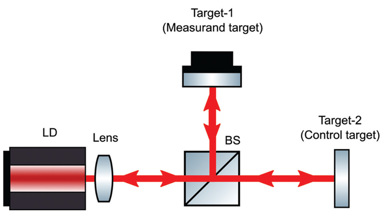 [Enlarge image]Dual-cavity OFI system.
[Enlarge image]Dual-cavity OFI system.
Optical feedback interferometry (OFI) using laser diodes is a widely recognized method for interferometric displacement sensing. Unfortunately, the method generates a periodic fringe pattern that fundamentally constrains its resolution to half the laser wavelength (λ/2). Concerted research in recent decades has aimed to surpass this λ/2 limitation and enhance OFI resolution. Techniques involving signal processing and optical phase modulation have been proposed and have successfully demonstrated resolutions as fine as λ/130. Yet these methods, too, often come with constraints—related to the operational range of the optical feedback or to the integration of additional components into the sensor system.
In recent work, we have introduced an innovative dual-cavity OFI that achieves nanoscale resolution by harnessing a high-frequency microwave photonics (MWP) signal to subdivide the conventional OFI fringe period. The dual-cavity system comprises two elements: a weak-feedback cavity that generates the OFI fringe from the target; and a second, stronger-feedback cavity ensuring that the laser operates in a period-1 (P1) oscillation state. In this dynamic state, the laser output combines the OFI fringe signal with a high-frequency MWP signal corresponding to the P1 oscillation frequency. The crux of our innovation lies in employing the MWP signal for sub-fringe division rather than for directly detecting fringe properties.
We verified the method’s effectiveness through both simulations and experiments. Simulations assuming a 780-nm laser demonstrated the potential to resolve displacements down to 0.003 nm, a remarkable five-orders-of-magnitude improvement relative to λ/2-limited OFI. Initial experimental results, using an 830-nm laser, achieved 0.02-nm resolution, a figure primarily restricted by photodetector bandwidth. Even this translates to a 2,500-fold enhancement in resolution compared with conventional OFI, employing common optical components within a straightforward setup.
Significantly, our work has revealed that laser dynamics and MWP generation can harmoniously combine with OFI to effectively surmount classical resolution limitations. The method’s simplicity, relying on basic laser diodes and optics, establishes a cost-effective avenue for achieving nanoscale displacement measurements, in contrast to pricier high-resolution interferometric techniques. We believe the exceptional resolution and intrinsic resistance to noise, derived from sub-fringe counting, confer substantial advantages across diverse precision-measurement applications in manufacturing, semiconductor inspection, scientific instrumentation and other areas.
In summation, our study has introduced and validated an innovative yet accessible nanoscale OFI sensing technique. With ongoing refinement, we believe this method, synergizing microwave photonics and laser dynamics, holds the potential to redefine the benchmarks for accurate and affordable displacement and vibration measurements across diverse domains. This heralds a transformative approach that, in our view, could propel optical interferometric sensing into unprecedented realms of resolution and measurement capability.
Researchers
Yuxi Ruan, Yanguang Yu, Qinghua Guo, Jiangtao Xi and Jun Tong, University of Wollongong, NSW, Australia
Bin Liu, University of Wollongong, NSW, Australia, and Xiangtan University, Hunan, China
References
1. Y. Ruan et al. Opt. Lasers Eng. 158, 107171 (2022).
